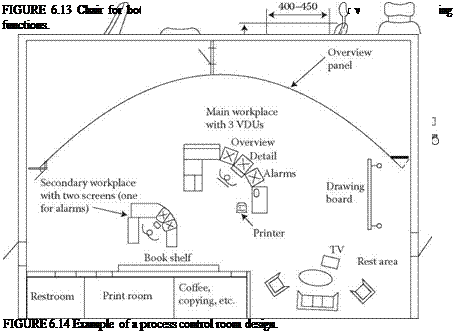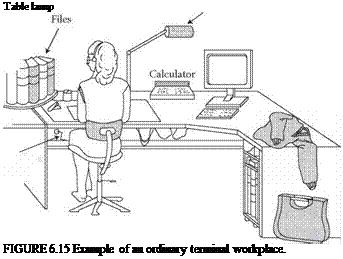Figure 6.14 shows an example of a layout for a control room. A workplace is placed centrally with access to a video display terminal (VDT), keyboard, and special controls. There is also space on the central workplace for writing and for various reference books. The process, which is assumed to be large, is displayed on the overview panel, mainly in the form of static information, but with the insertion of certain dynamic information such as the settings of the more important controls, critical readings, or deviations from the set values. The overview board is designed so that all parts of it are at more or less the same distance from the operator. There is also a more traditional office workplace in the control room, where various special tasks can be carried out during the daytime.
 |
In a control room where several people are working and there is an overview panel, it is important that this is positioned so that everyone can see it.
Figure 6.15 shows a more detailed design of a terminal workplace and for many ordinary office workplaces. Here, it is important that the workplace really is flexible with easily adjustable heights and distances of its various parts. If possible, it should also be possible to angle the keyboard and screen as shown in Figure 6.5b.
Adjustment
 control
control
Forlag.
Anshel, Jeffrey. (2005). Visual Ergonomics Handbook. Boca Raton, FL: CRC Press.
Ayers, Phyllis A., and Kleiner, Brian H. (2002). New Developments Concerning Managing Human Factors for Safety. Managerial Law 44, 1/2, 112-20.
Desai, Anoop, and Mital, Anil. (2005). Incorporating Work Factors in Design for Disassembly of Product Design. Journal of Manufacturing Technology Management 16, 7/8, 712-32.
Doggette, William T. (1995). Office Ergonomics. Benefits Quarterly 11, 4, 21-27.
Floyd, W. F., and Roberts, D. F. (1958). Anatomical and Physiological Principles in Chair and Table Design. Ergonomics 2, 1-16.
Floyd, W. F., and Ward, J. (1969). The Sitting Posture. Ergonomics 12, 132-39.
Grandjean, E. (1988). Fitting the Task to the Man (4th ed.). London: Taylor & Francis.
Mandal, A. C. (1982). Den Sittande Manniskan. Stockholm, Sweden: Liber Forlag.
Meshkati, Najmedin. (2003). Control Rooms’ Design in Industrial Facilities. Human Factors and Ergonomics in Manufacturing 13, 4 (Summer), 269-77.
Noyes, Jan, and Bransby, Matthew (eds.). (2001). People in Control: Human Factors in Control Room Design. London: IEE Press.
Valenti, Michael. (1995). A New Generation of Nuclear Reactors. Mechanical Engineering 117, 4 (April), 70-75.
Vink, Peter (ed.). (2004). Comfort and Design: Principles and Good Practice. Boca Raton, FL: CRC Press.
![]()



